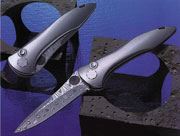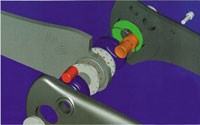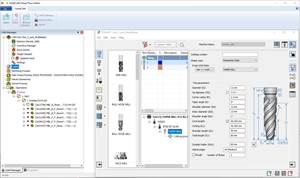Manufacturing Technology Keeps Knife Company On The Cutting Edge
'While most companies are dealing in thousandths of an inch, we're dealing in tens of thousandths. That's a lot more complex.'
TiNives (Fortson, Georgia) produces 5- to 7-ounce knives that feature a blend of balance, precision and innovation. "Our first product, which we call the Zero Play knife, was introduced at the Blade Show in Atlanta in 1998," says TiNives president and owner Scott Self. "While most folding knives feature about 20 parts, ours has more than 100. In addition, our first knife featured more than half a dozen innovations that the industry had never seen before."
TiNives knives are complex to design and machine, Mr. Self explains. "It takes more than 900,000 lines of code to produce one of our knives."
The button mechanism that opens the knife is extraordinarily smooth, pivoting on 84 ceramic balls that have a finish measured in tens of thousandths of an inch. "The nature of ceramic," explains Mr. Self, "is that it burnishes and polishes, so that the knife keeps getting smoother and smoother over time, without any surface removal. While most companies are dealing in thousandths of an inch, we're dealing in tens of thousandths. That's a lot more complex."
Material selection is also key. TiNives uses standard blade steel for the body and materials such as titanium and aircraft aluminum for knife handles. The knife handle features blind tapping holes, something that is difficult to do. The titanium knife handle is not only a complex sculpted shape that delivers excellent grip and feel, but it also features a textured surface etched into it, according to the company.
The complexity of TiNives' products demanded both design and machining software that was on the cutting edge. TiNives looked at a number of CAM systems. "One was priced at $30,000, and we thought it was overkill—after all, we weren't looking at machining airplanes and automobiles. As for the other, it just appeared to be very complicated program," says Mr. Self. So TiNives turned to SURFCAM software from Surfware, Inc. (Westlake Village, California). "We first saw SURFCAM at a machine shop in Florida," says Mr. Self, "and we knew almost immediately that it was the software for us. We showed them the knife we were working on, and the shop owner got on his laptop computer, imported IGES files from our Microcadam design, and two hours later showed us the texturing we wanted mapped directly onto a sculpted surface, in titanium. It was very impressive. We were literally sold on the spot. We had never seen this kind of texturing program in a CAM program."
Today the company offers half a dozen different knives in a variety of sizes and configurations, and all of its machining operations are running smoothly. "We have one texturing called the Wave, which is an American Flag waving in the breeze," reports Mr. Self. "It has something like 370,000 lines of NC code to it, and it puts the texture on top of a 3D sculpted surface."
"Let me give you another example of the type of NC work that we're doing," Mr. Self continues. "We just prototyped a double action knife in AutoCAD 2000, imported the files into our NC environment, and the very next day we had the tool paths for the inside and outside of the handle all done. By the second day we completed the programming for the blade. And on the third day we had toolpaths for all of the round parts completed. The bottom line is that in three days we took the part from start to finish, and that gives us a lot of confidence as we move forward. That's why we're talking about ramping up production from 500 pieces a month to one or two thousand."
For TiNives, like many small businesses, reliability is key. The products and technologies that it invests in must be reliable and "bullet proof," since the company can't afford any downtime. That is exactly what TiNives gets with its NC software. "We're using a three-axis milling module, we send our NC programs to a Fadal vertical machining center as well as an Excel milling machine, and in two years we have never had a problem, not once," says Mr. Self. "We often run our machines from 7 in the morning until midnight, and we have never had to get any type of support from Surfware. We have never had a problem."
Related Content
Improve Machining Efficiency Through Digital Twin Simulation
Full simulation of a machining cycle using digital twins can not only identify crashes before they happen, but provide insights that enable the user to reduce cycle times.
Read MoreBuilding A Powerful Bridge from the CAM Programmer to the Shop Floor Operator
SolidCAM for Operators provides a powerful bridge from CAM programming to the shop floor to best streamline the machine shop process with its CAM part simulation. It provides a clear picture to the operator for setup and prove-out, enables minor G-Code changes and avoids crashes, broken tools and scrapped parts.
Read MoreCan ChatGPT Create Usable G-Code Programs?
Since its debut in late 2022, ChatGPT has been used in many situations, from writing stories to writing code, including G-code. But is it useful to shops? We asked a CAM expert for his thoughts.
Read MoreAutomated CAM Programming – Is Your Software Really Delivering?
A look at the latest automation tools in Autodesk Fusion 360 software and how forward-thinking machine shops and manufacturing departments are using them to slash delivery times and win more business.
Read MoreRead Next
3 Mistakes That Cause CNC Programs to Fail
Despite enhancements to manufacturing technology, there are still issues today that can cause programs to fail. These failures can cause lost time, scrapped parts, damaged machines and even injured operators.
Read MoreThe Cut Scene: The Finer Details of Large-Format Machining
Small details and features can have an outsized impact on large parts, such as Barbco’s collapsible utility drill head.
Read More
















.png;maxWidth=300;quality=90)













